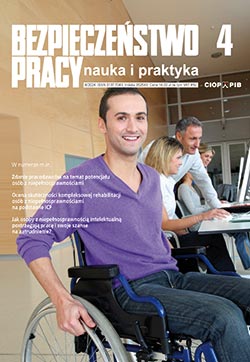Stereotypes about older workers and their connection to wellbeing and work – a literature review
Zofia Mockałło
This paper presents the concept of stereotype and the mechanisms of its impact. Specifically, this paper focuses on older workers because of the need to maintain their occupational functioning at a high level in the context of the extended retirement age and an aging population. On the basis of a literature review, this paper discusses positive and negative stereotypes about older workers, and their negative effects, e.g., lower work motivation, less common development of occupational skills and lower work ability.
Cellular ageing (senescence) and its consequences for humans
Katarzyna Miranowicz-Dzierżawska
Demographic changes and the increasing percentage of occupationally active elderly people require considering the specifics of a more advanced age in dealing with hazards in the working environment, and broadening the scope of research in occupational health and safety by studying aging organisms. This article discusses current theories of cell aging, changes in organs and tissues associated with old age, as well as tests carried out on senescent cells in vitro.
Protection of older workers from development of musculoskeletal disorders
Danuta Roman-Liu
The article presents the issues related to the development of musculoskeletal disorders (MSDs). It presents factors laying behind the MSDs development and the model of its development. The model takes into account exposure, i.e. the load conditioned on workstand; dose, which is the level of the load on the internal structures; capacity corresponding to the physical capabilities of the employee and the response, which is a direct feature of the model that determines the development of the disease. The paper presents selected data showing
MSDs among workers of the EU (27) in different age groups, the knee extension strength in the elderly population and changes in the values of the maximum strength of the knee, which manifest themselves under the influence of physical training. As a summary is presented a statement that counteraction of functional changes in the musculoskeletal system that occurs with age can be done by adjusting the job to the possibility of the elderly, as well as through the implementation of programs of rehabilitation of the elderly and people with disabilities.
Characteristics of the risks and causes of accidents in the printing industry
Agnieszka Ubowska
There are about 8800 entities with over 49000 workers in the printing industry in Poland. A survey (GUS, 2013) on 30655 workers showed that 7625 (about 25%) of them had experienced hazardous situations at work. Over 15% of them worked in hazardous conditions related to the working environment, strenuous work and mechanical factors. This paper evaluates occupational hazards in printing-houses focusing on the kind and frequency of accidents in the past few years. The analysis showed that despite the wide range of risks in the printing industry, accidents were generally light and they affected a relatively small group of workers. This paper also assesses risk in accordance with standard PN-N-18002:2011.
Classifying personal protective equipment on the basis of Directive 89/686/EEC: protective gloves and footwear
Agnieszka Stefko
Before personal protective equipment (PPE) is placed on the EU market it must undergo a relevant procedure of conformity assessment in relation to essential health and safety requirements listed in Directive 89/686/EEC. The procedure depends on the category of PPE, to which the product has been classified. The product's intended use and its protective properties declared by the manufacturer are the starting point in classifying PPE. Directive 89/686/EEC is the basic document in this matter. The European Commission also develops documents with guidelines for classifying different types of PPE, which facilitate the process for manufacturers. This paper describes the principles of classification using protective gloves and footwear as an example. It also indicates sources of information on classification and presents examples of gloves and footwear in three categories.




























